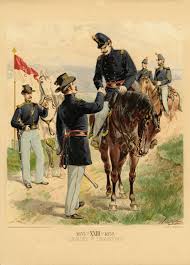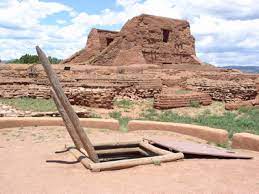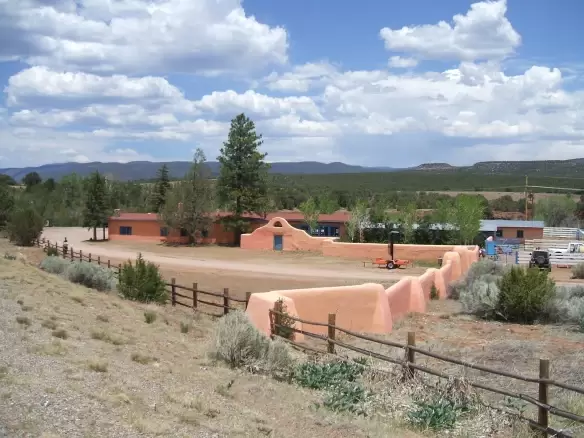
The decisive battle in the Confederacy's attempt to take New Mexico during the Civil War took place on March 26-28, 1862. Called the Battle of Glorieta, or the Battle of Glorieta Pass, it ranged through a narrow mountain pass that was the last leg of the Old Santa Fe Trail before it reached Santa Fe. Three ranches, owned by three very different characters, were settings for this battle.

Martin Kozlowski came to the area by a circuitous route. He was born in Warsaw, Poland in 1827 and fought in the 1848 revolution against the Prussians. He was a refugee for two years in England, during which time he met and married an Irish woman named Ellene. The two immigrated to American in 1853, and Martin enlisted in the First Dragoons, who were fighting Apaches in the Southwest.
Martin must have fallen in love with New Mexico during his Army years. In 1858 he mustered out and used his 160-acre government bounty land warrant to purchase the land on the far eastern edge of Glorieta Pass. Here, the Pecos River meets Glorieta Stream in a wide, flat area that is well watered and has fertile soil. Kozlowski's 600 acre spread included 50 improved acres, which consisted of a home for the family, a trading post, a tavern, and rooms for travelers. It had a spring for fresh water, and lots of forage for horses and mules. The 1860 agriculture census shows that Kozlowski grew corn and raised livestock, but a lot of his livelihood came from accommodating for travelers on the Santa Fe trail.
Martin must have fallen in love with New Mexico during his Army years. In 1858 he mustered out and used his 160-acre government bounty land warrant to purchase the land on the far eastern edge of Glorieta Pass. Here, the Pecos River meets Glorieta Stream in a wide, flat area that is well watered and has fertile soil. Kozlowski's 600 acre spread included 50 improved acres, which consisted of a home for the family, a trading post, a tavern, and rooms for travelers. It had a spring for fresh water, and lots of forage for horses and mules. The 1860 agriculture census shows that Kozlowski grew corn and raised livestock, but a lot of his livelihood came from accommodating for travelers on the Santa Fe trail.
 The Spanish mission church at Pecos Pueblo. The entrance to a kiva is in the foreground
The Spanish mission church at Pecos Pueblo. The entrance to a kiva is in the foregroundThis area had been settled long before the Santa Fe Trail opened. Perhaps the first settlers in the area were the people who founded Pecos Pueblo sometime around AD 1100. Historically known as Cicuye (sometimes spelled Ciquique), which mean the "village of 500 warriors," the Pueblo was visited by the Spanish explorer Francisco Vásquez de Coronado in 1540. The Spanish mission church was built in 1619 and the kiva in 1680, after a revolt that caused the Spanish to abandon the area. In 1838, attacks by Comanches compelled the inhabitants to abandon the area and move in with their relatives at the Walatowa Pueblo in Jemez. Twenty years later, Kozlowski moved to the area and used some of the timbers and bricks from the abandoned pueblo to build his buildings.
 Martin Kozlowski in front of his trading post.
Martin Kozlowski in front of his trading post.
Kozlowski's ranch became site of Camp Lewis, the headquarters for the Union Army during the Battle of Glorieta. The troops were mostly men from Colorado, who had come from Camp Wells in Denver, through Raton Pass, and stopped in Fort Union. Their leader, John Slough, intended to engage the Confederates in Santa Fe and was surprised to encounter Confederate troops in the pass.
The Union Army continued to maintain a hospital in Kozlowski's tavern for another two months after the battle was over.
After the war, Kozlowski complimented them, saying “When they camped on my place, they never robbed me of anything, not even a chicken.” Perhaps their good behavior was because Kozlowski was former military himself.
The Union Army continued to maintain a hospital in Kozlowski's tavern for another two months after the battle was over.
After the war, Kozlowski complimented them, saying “When they camped on my place, they never robbed me of anything, not even a chicken.” Perhaps their good behavior was because Kozlowski was former military himself.
The early 1870s appear to be the high point for the Kozlowski family's enterprises. In 1873, U.S. Attorney T.B. Catron sued him for violating a federal law that prevented non-Indians from settling on pueblo land grants. The case went all the way to the Supreme Court, but ultimately Martin paid $1,000 and was able to keep his land. In 1880 the Atchison, Topeka, and Santa Fe Railroad ran its line through the canyon, effectively ending the lucrative Santa Fe Trail traffic. Soon thereafter, Kozlowski moved to Albuquerque, where he died in 1905.

Kozlowski's ranch traded hands several times after he left it. Sometimes, it was a working ranch. At other times, It became a dude ranch where tourists could live like pampered cowboys. In 1939, a Texas oilman and rancher named Buddy Fogelson bought the property and renamed it The Forked Lightning Ranch. Fogelson's widow, the actress Greer Garson, donated the ranch to the National Park Service in 1991. It is now part of Pecos National Park.

Kozlowski's Ranch is one of the major settings for The Worst Enemy, which will be published August 15, 2023 and is available for preorder at Bookshop.org.
The Worst Enemy is book 2 of Rebels Along the Rio Grande, a trilogy of middle grade historical novels about New Mexico during the Civil War.
Book 1: Where Duty Calls, is available in ebook and paperback. It was a finalist for both the NM Women's Press Zia award and the Western Writer's of America spur award in 2023.
The Worst Enemy is book 2 of Rebels Along the Rio Grande, a trilogy of middle grade historical novels about New Mexico during the Civil War.
Book 1: Where Duty Calls, is available in ebook and paperback. It was a finalist for both the NM Women's Press Zia award and the Western Writer's of America spur award in 2023.





No comments:
Post a Comment